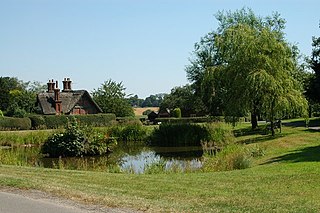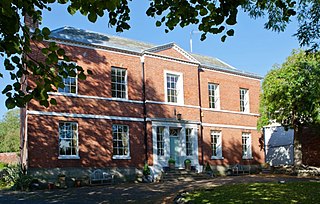
Ripley is a town in the Amber Valley borough of Derbyshire, England.

Alleyne FitzHerbert, 1st Baron St Helens, PC was a British diplomat. He was Minister Plenipotentiary to Russia from 1783 to 1788, appointed Chief Secretary for Ireland and a member of the Privy Council in 1787, serving in the former position until 1789. He was Minister plenipotentiary to Spain from 1790 to 1794.

St Oswald's Church is a Church of England parish church located in Ashbourne, in the county of Derbyshire, England.

Bradley is a village and civil parish in Derbyshire just east of Ashbourne. The population of the civil parish taken at the 2011 Census was 313. Other neighbouring parishes include Hulland and Yeldersley.

The Butterley Company was an English manufacturing firm founded as Benjamin Outram and Company in 1790. Its subsidiaries existed until 2009.

This is a list of Sheriffs of Derbyshire from 1567 until 1974 and High Sheriffs since.

Alfreton Hall is a country house in Alfreton, Derbyshire. It was at the heart of local social and industrial history in the county. The history of the estate goes back to Norman times, but by the 17th century it was owned by the Morewood family, who were linked to local industry, mainly in coal mining.
Henry FitzHerbert Wright was an English cricketer, lawyer and Conservative politician. He was active in local government in Derbyshire and sat in the House of Commons from 1912 to 1918.

Sir John Port was an English landowner and Knight of the Order of the Bath who served occasionally in the House of Commons. He was Sheriff of Derbyshire in 1554. By his will, he founded Repton School and almshouses at Etwall. He also owned Caverswall Castle from 1531 after acquiring it through marriage to Elizabeth.

Osmaston is a small village and civil parish in the Derbyshire Dales in the county of Derbyshire in England. The population of the civil parish as taken at the 2011 Census was 140.

Sir Brooke Boothby, 6th Baronet was a British linguist, translator, poet and landowner, based in Derbyshire, England. He was part of the intellectual and literary circle of Lichfield, which included Anna Seward and Erasmus Darwin. In 1766 he welcomed the philosopher Jean-Jacques Rousseau to Ashbourne circles, after Rousseau's short stay in London with Hume. Ten years later, in 1776, Boothby visited Rousseau in Paris, and was given the manuscript of the first part of Rousseau's three-part autobiographic Confessions. Boothby translated the manuscript and published it in Lichfield in 1780 after the author's death, and donated the document to the British Library in 1781.
Henry Isaac Stevens FRIBA was an architect based in Derby. He was born in London, in 1806, and died in 1873. In the late 1850s he changed his name to Isaac Henry Stevens.
Edward Miller Mundy was an English landowner and Tory politician who was MP for the Derbyshire constituency.

Somersal Herbert Hall is a privately owned timber-framed 16th-century country house at Somersal Herbert, near Ashbourne, Derbyshire, in England. It is a Grade I listed building.
Ashbourne Hall is a Manor house originally built by the Cockayne family in the 13th century in Ashbourne, Derbyshire. The present building is part of a largely demolished, Georgian-styled hall built in the 18th century.
Sir John Cockayne was an English soldier, politician and landowner whose wealth made him a major force in the affairs of Derbyshire under the House of Lancaster. After numerous acts of criminality in concert with other Midlands landowners, he became a member of the Lancastrian affinity centred on John of Gaunt and a supporter of Henry IV. He fought in two campaigns of the Hundred Years War but his violence and lawlessness continued and he was decidedly out of favour during the reign of Henry V. With power less concentrated in the early years of Henry VI, he was able to serve three terms as High Sheriff of Nottinghamshire, Derbyshire and the Royal Forests and to wield considerable power and influence. He represented Derbyshire no less than nine times and Warwickshire twice in the House of Commons of England.

St Mary and St Barlock's Church, Norbury is a Grade I listed parish church in the Church of England in Norbury, Derbyshire.

Breedon Hall, Breedon on the Hill in north-west Leicestershire, is a house of historical significance and is listed on the English Heritage Register. In 1620 it was a small timber-framed cottage. Soon after it was bought by the Curzon family and was successively enlarged until 1777 when it was given a new Georgian front. It was the ancestral home of the Curzons for over three centuries and then bought by the Shields family. Today it is owned by the Meynell family and provides bed-and-breakfast accommodation.

Clifton and Compton is a civil parish within the Derbyshire Dales district, in the county of Derbyshire, England. The parish, despite the name, only includes the villages of Clifton and Hangingbridge. In 2011 the parish had a population of 500. It is 124 miles (200 km) north west of London, 13 miles (21 km) north west of the county city of Derby, and 1+1⁄3 miles south west of the market town of Ashbourne. Clifton and Compton touches the parishes of Ashbourne, Edlaston and Wyaston, Mayfield, Offcote and Underwood, Osmaston, Okeover and Snelston. There are eight listed buildings in Clifton and Compton.

Francis Wright JP DL, was a British industrialist and philanthropist.



















